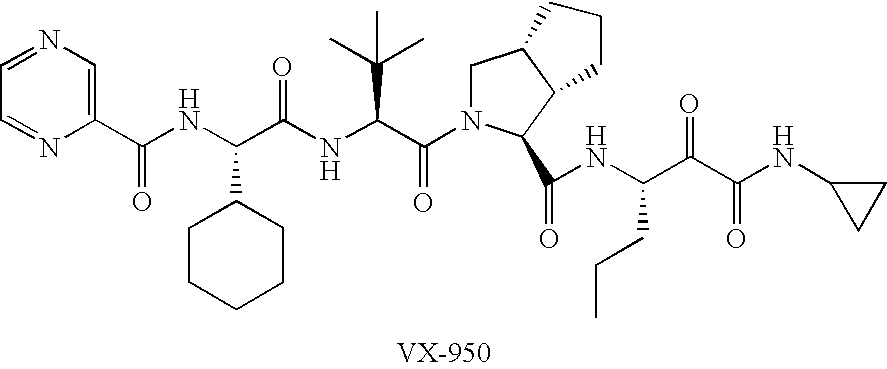Combinations for HCV treatment
a technology of hcv and conjugates, which is applied in the field of conjugates for hcv treatment, can solve the problems of insufficient anti-hcv agents or treatments, no broadly effective treatments for the debilitating progression of chronic hcv, and significant side effects of interferons
- Summary
- Abstract
- Description
- Claims
- Application Information
AI Technical Summary
Benefits of technology
Problems solved by technology
Method used
Image
Examples
example 1
HCV Replicon Cell Assay Protocol
[0083] Cells containing hepatitis C virus (HCV) replicon were maintained in DMEM containing 10% fetal bovine serum (FBS), 0.25 mg per ml of G418, with appropriate supplements (media A).
[0084] On day 1, replicon cell monolayer was treated with a trypsin:EDTA mixture, removed, and then media A was diluted into a final concentration of 100,000 cells per ml wit. 10,000 cells in 100 μl were plated into each well of a 96-well tissue culture plate, and cultured overnight in a tissue culture incubator at 37° C.
[0085] On day 2, compounds (in 100% DMSO) were serially diluted into DMEM containing 2% FBS, 0.5% DMSO, with appropriate supplements (media B). The final concentration of DMSO was maintained at 0.5% throughout the dilution series.
[0086] Media on the replicon cell monolayer was removed, and then media B containing various concentrations of compounds was added. Media B without any compound was added to other wells as no compound controls.
[0087] Cell...
example 2
HCV Ki Assay Protocol
[0090] HPLC Microbore Method for Separation of 5AB Substrate and Products
[0091] Substrate:
[0092] NH2-Glu-Asp-Val-Val-(alpha)Abu-Cys-Ser-Met-Ser-Tyr-COOH
[0093] A stock solution of 20 mM 5 AB (or concentration of your choice) was made in DMSO w / 0.2M DTT. This was stored in aliquots at −20° C.
[0094] Buffer: 50 mM HEPES, pH 7.8; 20% glycerol; 100 mM NaCl
[0095] Total assay volume was 100 μL
X1 (μL)conc. in assayBuffer86.5See above5 mM KK4A0.525μM1 M DTT0.55mMDMSO or inhibitor2.52.5%v / v50 μM tNS30.0525nM250 μM 5AB2025μM(initiate)
[0096] The buffer, KK4A, DTT, and tNS3 were combined; distributed 78 μL each into wells of 96 well plate. This was incubated at 30 C for ˜5-10 min.
[0097] 2.5 μL of appropriate concentration of test compound was dissolved in DMSO (DMSO only for control) and added to each well. This was incubated at room temperature for 15 min.
[0098] Initiated reaction by addition of 20 μL of 250 μM 5 AB substrate (25 μM concentration is equivalent or ...
example 3
Metabolic Stability of NS3 / 4A Protease Inhibitors Interaction of Ritonavir in the Metabolism of VX-950
[0115] The metabolism of VX-950 and the interaction with ritonavir was investigated using human hepatic microsomes. Initial incubations were performed in a 0.1 M phosphate buffer, pH 7.4, containing 1 mM EDTA, NADPH, 1 μM VX-950, and either 0.1, 0.5, or 1.0 mg microsomal protein / mL for various time points. Due to non-linear rates of metabolism, additional incubations were performed containing either 0.25 or 0.5 mg microsomal protein / mL at two concentrations of VX-950 (0.5 and 1 μM) for up to 30 minutes.
[0116] Due to the apparent rapid metabolism of VX-950 in human hepatic microsomes, the kinetics (Vmax and Km) of VX-950 metabolism was determined using a protein concentration of 0.25 mg / mL and an incubation time of 2 minutes. The interaction of ritonavir on the metabolism of VX-950 was determined by incubating a single concentration of VX-950 (0.25 μM) and human hepatic microsomes...
PUM
| Property | Measurement | Unit |
|---|---|---|
| Concentration | aaaaa | aaaaa |
| Level | aaaaa | aaaaa |
| Bioavailability | aaaaa | aaaaa |
Abstract
Description
Claims
Application Information
 Login to View More
Login to View More - R&D
- Intellectual Property
- Life Sciences
- Materials
- Tech Scout
- Unparalleled Data Quality
- Higher Quality Content
- 60% Fewer Hallucinations
Browse by: Latest US Patents, China's latest patents, Technical Efficacy Thesaurus, Application Domain, Technology Topic, Popular Technical Reports.
© 2025 PatSnap. All rights reserved.Legal|Privacy policy|Modern Slavery Act Transparency Statement|Sitemap|About US| Contact US: help@patsnap.com

